Carbon Utilisation: What Can We Do With Captured CO₂?
11 minute read
Updated on: 02 Jul 2021
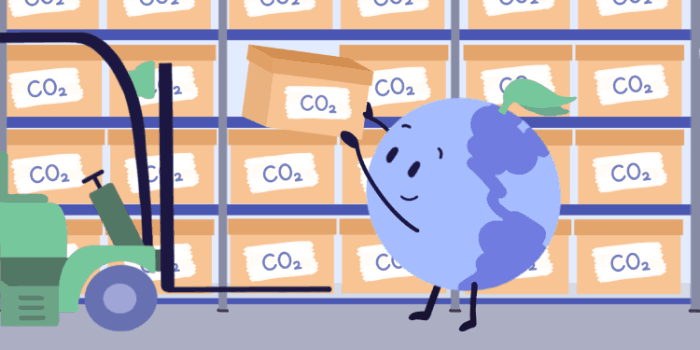
What if we could safely utilize the CO₂ we capture instead of just storing it away underground?
Most of the CO₂ that we capture will be stored away underground. But what if we could use it to make something else ?
How can we make use of captured CO₂?
Just like metal, minerals, and timber, CO₂ can be used as an industrial resource! . Making use of CO₂ captured from carbon capture technologies could make these technologies more profitable and competitive, thus increasing their adoption across industrial sectors
. Additionally, by using the captured CO₂, the costs of creating and maintaining CO₂ storage sites will also be reduced. Indeed, the market for the utilization of captured CO₂ has the potential to be worth billions of dollars
.
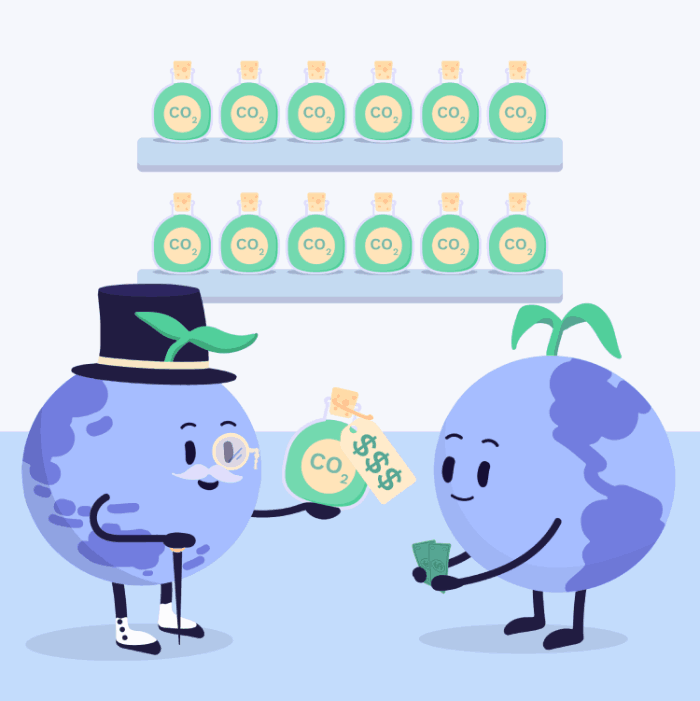
Fancy Earthly selling CO₂
Where can we use captured CO₂?
Once the CO₂ is captured via the pathways outlined in the previous chapters, it can be used in multiple ways. Since the beginning of the 20th century, we have used CO₂ directly in various industrial applications
:
Preserved food: Solid CO₂ (dry ice) is also used in the refrigeration and frozen storage of foods like ice cream and meat .
Fertilizer production: CO₂ can also be used to manufacture minerals and fertilizer, such as urea, to provide plants with the nitrogen they need to grow .
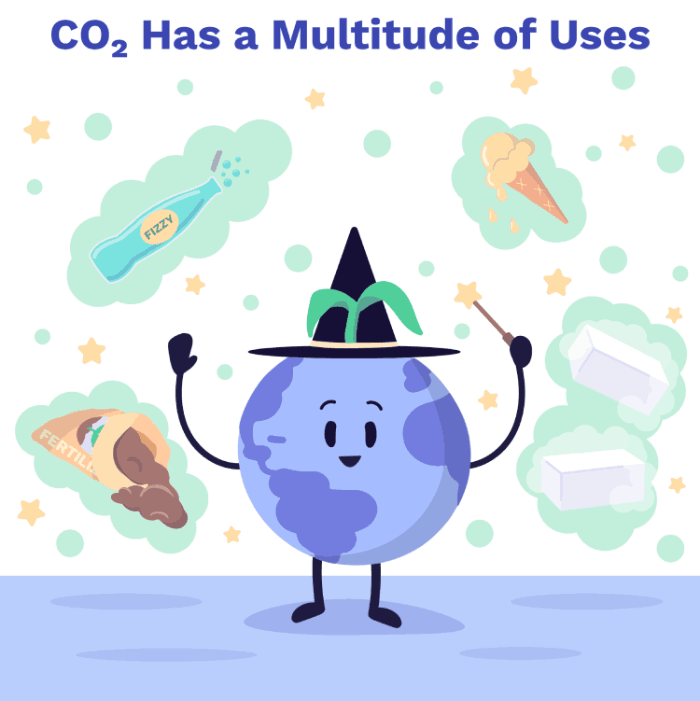
Who would’ve known we could use CO₂ for so many things
Enhanced oil recovery (EOR): Although controversial, CO₂ can be used in the extraction of crude oil from an oil deposit that could not otherwise be extracted (due to it being very hard to reach) as a way of maximizing the oil reserves that can be recovered . The process works by injecting CO₂ into depleted oil reservoirs.
Extracting remaining oil with this method could prevent further oil exploration and drilling as we transition to a carbon-neutral world.
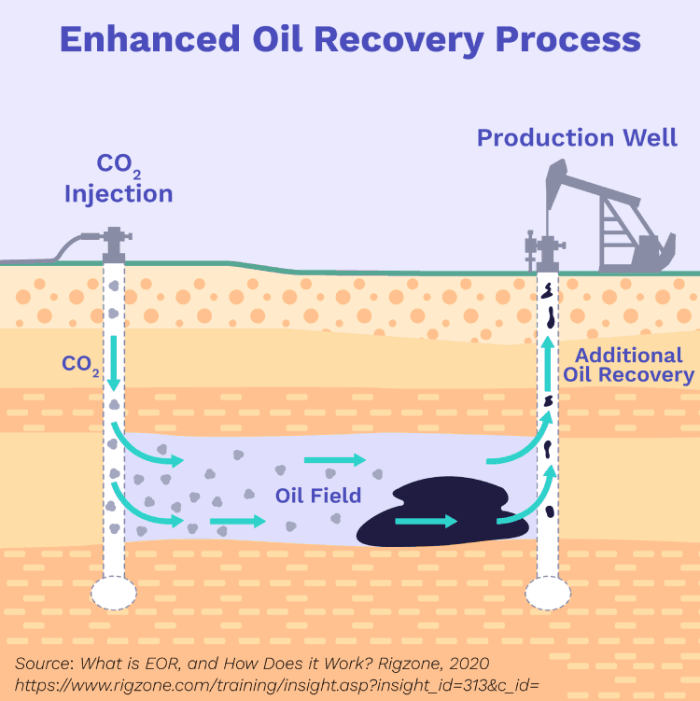
Using CO₂ to have more efficient oil extraction
The CO₂ needed for these utilization processes is usually obtained as a by-product from other industrial operations such as the decomposition of limestone or the manufacture of hydrogen gas .
Global use of CO₂:
Currently, we use around 120 Mt of CO₂ per year for these applications, whilst emitting around 36000 Mt of CO₂ back into the atmosphere from all our other activities . Carbon capture technologies aim to remove some of the excess CO₂ emitted into the atmosphere, and carbon utilization allows this captured CO₂ to be used in the industrial processes discussed above.
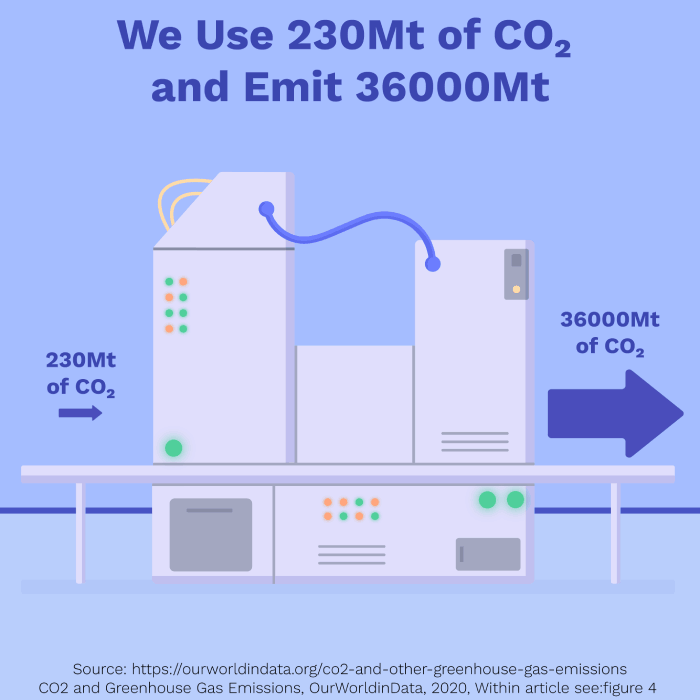
Our use of CO₂ is not well balanced
A new class of products and materials are being developed that utilize captured CO₂ in innovative and non-traditional ways. Globally, several organizations and programmes have been established that have furthered innovation in the utilization of captured CO₂, such as the NRG COSIA Carbon XPRIZE and the Global CO₂ Initiative .
How can we chemically convert CO₂ into more useful products?
Chemical conversions of CO₂ can produce fuels, chemicals, plastics and other useful commodities via different catalytic pathways (reactions that involve the activity of a catalyst) . A catalyst is something that speeds up the rate of a reaction without being used up itself in the process. Catalytic pathways are usually required for CO₂ conversion as CO₂ is a stable, low energy molecule, which requires a high input of energy to be converted into other products
. Using a catalyst can offset some of the energy required for the desired conversion, as shown by the following figure
.
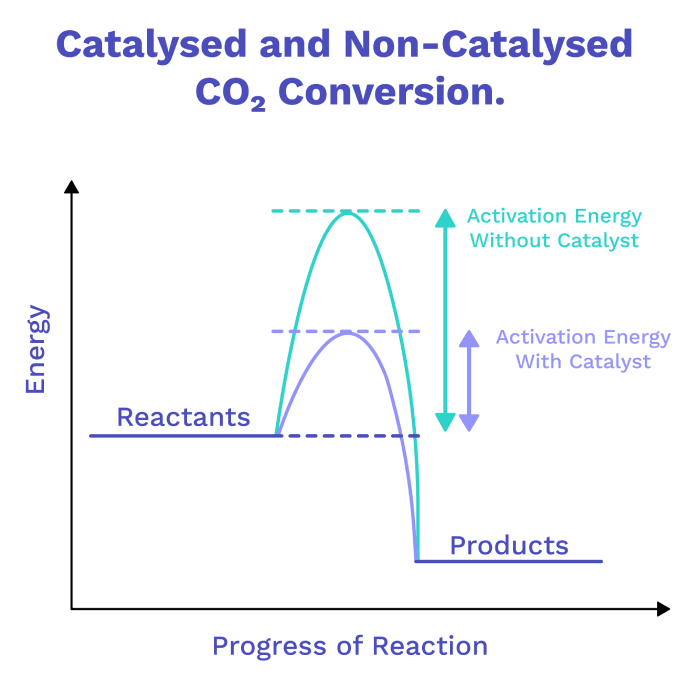
Using a catalyst reduces the energy required to convert CO₂
There are various forms that catalytic pathways can take. Here are some examples:
Electrochemical conversion : This pathway, known as electrolysis, uses electricity and catalysts to reduce CO₂ into useful chemicals such as methane, methanol, and carbon-neutral hydrocarbon fuels
. The following reaction shows how methane can be made using this pathway:
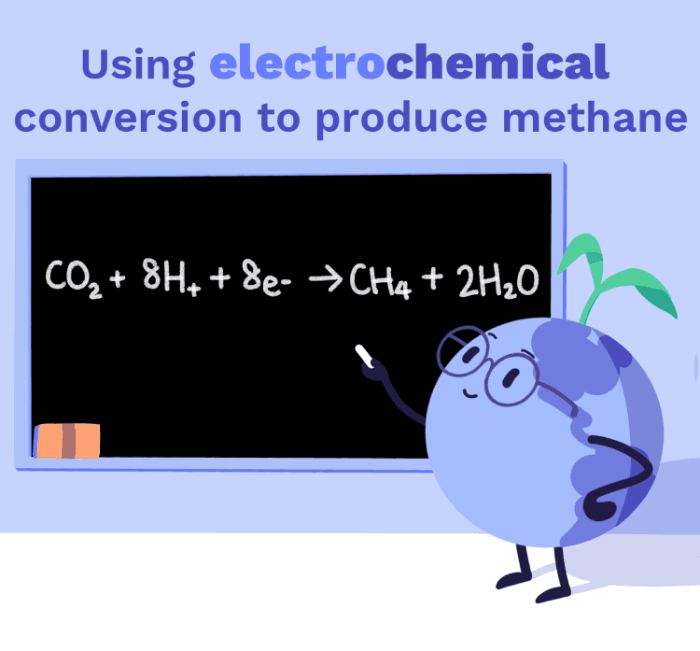
Using electrochemical conversion to produce methane
Photochemical conversion: This pathway mimics the natural process of converting CO₂ (photosynthesis) into useful chemicals by using electrochemical cells (devices that generate electricity via chemical reactions) . Here, solar energy is used alongside a catalyst to provide the energy needed for CO₂ conversion
.
Thermochemical conversion and hydrogenation : This pathway uses the input of heat and a catalyst to reduce CO₂ molecules. It involves combining hydrogen with the CO₂ to form the desired chemicals or fuels. For example, the following reaction shows how methanol (an alcohol and fuel source) can be made:
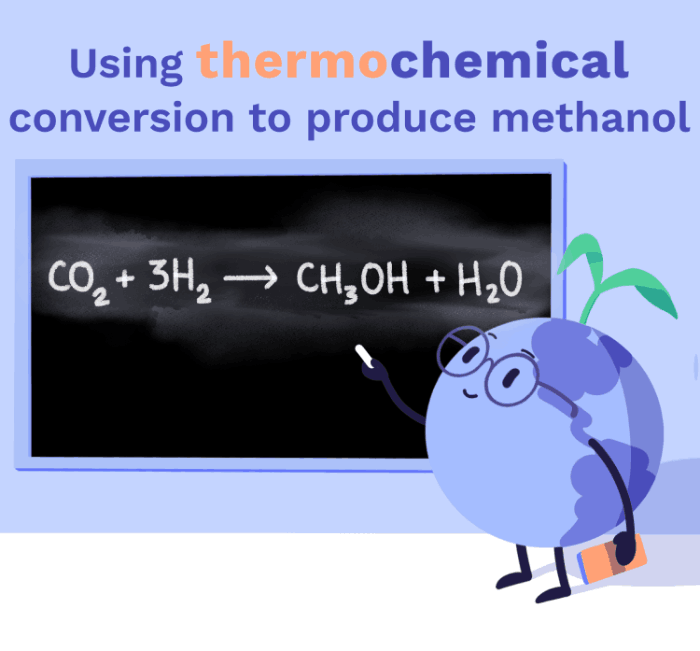
Using thermochemical conversion to produce methanol
It is important to ensure that the hydrogen used for this reaction is made via electrolysis using energy from renewable sources. Most of our hydrogen today comes from natural gas and is actually responsible for 2% of global greenhouse gas emissions . To read more about this check out our hydrogen chapter in our energy course.
Can we convert CO₂ using biological processes?
Yes! This pathway is similar to photochemical conversion in the way it converts CO₂ into fuels. However, biological conversion makes use of biological organisms that produce their own food from light, water or other chemicals (e.g algae or bacteria) instead of electrochemical cells. These organisms fix CO₂ into chemicals using photosynthesis and natural metabolic processes .
Currently, LanzaTech has developed a biological conversion pathway that uses microbial activity to convert CO₂ from industrial exhaust into chemicals such as ethanol, an alcohol .
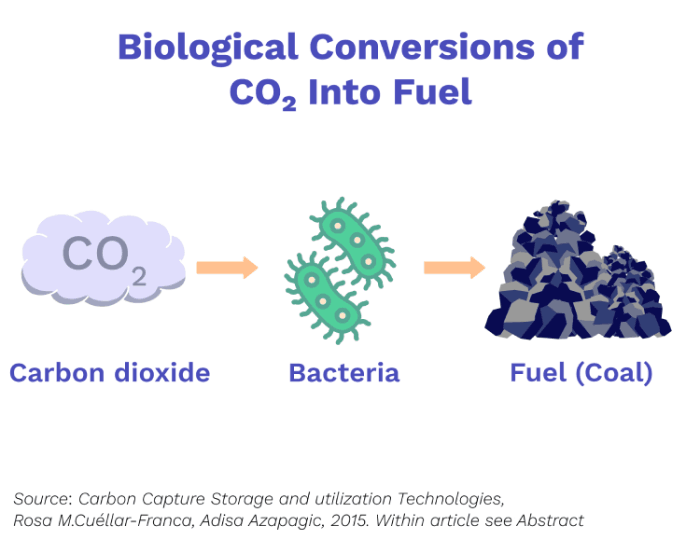
Biological conversions of CO₂ into fuel
Are there any other ways of converting CO₂?
The last pathway we’ll talk about is called mineralization. This pathway converts CO₂ to a more stable form of carbon, typically a carbonate, which can then be used to make useful materials .
For example, captured CO₂ can be mixed with wet concrete in a process known as CO₂-curing. This permanently stores the CO₂ as a mineral in the concrete product . This technology is easy to install in current production machines and has relatively low costs
. Indeed, several companies, such as CarbonCure and Carbon Upcycling Technologies, have incorporated some form of this process into their concrete and cement mixes.
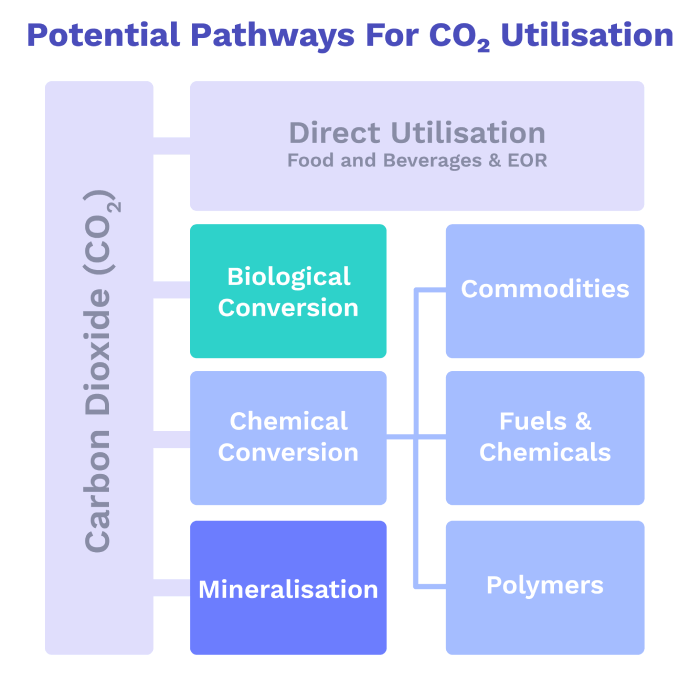
There’s a lot that we can do with CO₂
Why can’t we just use all the CO₂ we capture?
The scale of CO₂ utilization as an industrial resource is very small compared to the amount of CO₂ produced by the industrial sector as a whole . Hence, the global demand for chemicals and materials that use CO₂ cannot meet the amount of CO₂ that needs to be captured and utilized
. This is why most of the CO₂ we capture will be stored away.
Likewise, the research needed for developing pathways for CO₂ utilization is still underway, and most technologies and companies working on novel CO₂ utilization are still at a demonstration-scale. This means that these technologies may not be fully developed on a large enough scale in time to mitigate climate change.
Lastly we need to ensure that the carbon utilization process is at least net carbon neutral, if not carbon negative. Constructing these pathways requires a lot of research and experimentation, not to mention money . By contrast, we know that storing CO₂ in rock formations will last a long time and comes at a relatively cheap cost.
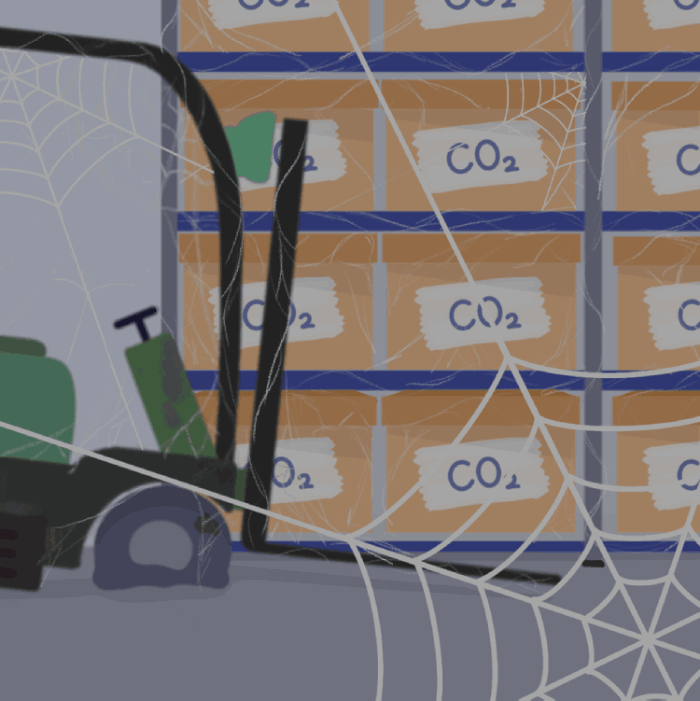
CO₂ in the ground is safe for a long time
Whilst several companies and organizations have invested in novel pathways for CO₂ utilization, there are still many political barriers that prevent these pathways from reaching their potential scale.
There are several perception barriers to using products that are derived from captured CO₂ as many fear that using CO₂ will only increase our reliance on fossil fuels. However, companies that are working on developing captured CO₂ products argue that reliance on fossil fuels would not be an issue as we have other means of capturing it that don’t involve burning fossil fuels.
What could carbon capture, utilization and storage (CCUS) look like in the future?
In the future, developing CCUS ‘hubs’ in industrial areas with shared transport and storage infrastructure will allow for cost reduction for facilities incorporating carbon capture into production processes .
With much of the world still dependent on fossil fuels today, it is unlikely that we will see a large-scale energy transition to renewable energy very soon. As such the need for CCUS is likely going to increase.
However, reducing the source of emissions is always the ultimate goal. As we urgently try to decarbonise our energy sources, capturing the carbon at source and removing it from the atmosphere provides a stopgap mechanism, buying time while the development of low-carbon, energy-efficient and renewable energy technologies continue .